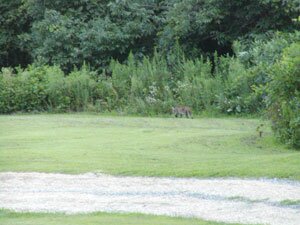NEWS- 'I'm not crazy!' Witness sticks by cougar sighting

Susie Humphreys is hoping a motion sensitive camera will capture the cougar she's seen on numerous occasions.
PHOTO BY COURTENEY STUART
Last month, Marlene "Susie" Humphreys called wildlife officials to report her frequent sightings of a mountain lion around her Crozet home and her fear for her seven-year-old granddaughter's safety. Now she's not just afraid. She's angry following news reports in which those officials suggest she's mistaking a bear or some other animal for the big cat.
"I'm almost 50 years old," says Humphreys, shaking her head. "I think I can tell the difference between a cat and a bear."
She can also tell the difference, she says, between a bobcat– which has a short tail and typically weighs under 40 pounds– and a mountain lion, which has a long tail and can weigh up to 200 pounds.
"I was born in the country," she says. "I'm not some city girl."
The saga of the Crozet cougar is not new. Last summer, controversy erupted followed a series of cougar sightings. Philip Anderson, a Maryland man who's hoping to move to Crozet, wrote a letter in the Crozet Gazette warning locals of the dangers cougars pose to people– particularly to small children. Anderson's warning, however, was not appreciated by many, who flogged him in a flood of published responses.
"Stay in the big city where you are more likely to be 'mangled' by one of your own kind," wrote one, "rather than come here and impose your tyrannical views on our wildlife."
Danger posed by mountain lions, others wrote, is minimal since the animals are shy and have a huge natural food supply of white tailed deer and smaller mammals.
Anderson points to mountain lion attacks in California, and says anytime large predators live in close proximity to humans, there's a risk. He doesn't advocate killing cougars; he'd like them relocated to areas where they pose less danger. Humphreys' experience, Anderson now says, could become more common and lead other Crozet residents to fear for their children's safety.
Humphreys first told her story to a television news crew from CBS 19 on February 26. The big cat, she said, prowls her backyard, eating her dogs' food, and on one occasion, scratching on her granddaughter's bedroom window. Humphrey believes the cougar was tempted by two pet guinea pigs squeaking inside, and while she didn't actually see the cat on that occasion, she found paw prints outside the window the following day.
The day after that first story ran on television, however, officials from the Department of Game and Inland Fisheries questioned Humphreys' claims in a follow-up report on Channel 19 and in a Daily Progress article titled "A Crozet catamount or just crazy talk?" Humphreys resents the implication of the headline.
"I may be a lot of things," she says, "but I'm not crazy."
Humphreys is not the only one who's seen the animal around her St. George Avenue house. David Shifflett, the father of Humphreys' granddaughter, Brianna, says he got up close to a cougar in late January when he was leaving the house one evening. About 20 feet in front of his car, light from his headlights illuminated the animal Humphreys had warned him about earlier that day.
"It bared its teeth," Shifflett recalls, reporting that his first instinct was to run over the animal to end the terror it's causing Humphreys. But as he pressed on the gas, the startled cat fled. "It was not a bobcat, a bear or a coyote," he insists.
Shifflett and Humphreys are not the only ones frustrated that a local cougar sighting hasn't been taken seriously.
Dozens of people, including a veterinarian, have reported seeing cougars around Crozet in the past decade.
One of those people says he has proof of a cougar around his mountainside house in Greenwood. A grainy photograph Richard Gaya took in 2004– which has run in the Crozet Gazette, the Hook, and now the Daily Progress– seems to show a large cat with a long tail. But even such photographic evidence isn't enough to convince officials that cougars are here.
"It looks like a bobcat to me," says Jerry Sims, Fredericksburg-based wildlife biologist and manager for the Virginia Department of Game and Inland Fisheries, of Gaya's picture.
Gaya counters that the photo leaves no room for interpretation.
"There's no way in the world you can't come to the conclusion," he says, "that this thing weighs at least 80 pounds."
Sims says the only hard proof his department will accept is a cougar carcass, and even that wouldn't prove more than that one such beast is roaming about. He says it's possible someone released a captive cougar into the wild, and he doesn't believe there's evidence of a "reproducing population."
Still, his department is finally taking steps to confirm what Humphreys saw. On Friday, February 29, a game warden mounted a motion-sensitive camera on a tree in her back yard. If the cat goes by, it will be captured on the department's own film. If its existence is confirmed, the department could set a trap to capture it or use dogs to "tree" it. The department would then relocate it to an area unpopulated by humans.
Until that happens, Humphreys and her husband, Harvey, aren't taking any chances. Although it's illegal to kill a mountain lion, which is considered endangered, the couple now keeps a loaded gun in the house to defend themselves.
"I don't like guns to start with," she says, "and to have to keep one loaded?"
She and Harvey say they wouldn't think twice about shooting the endangered animal to save something else.
"My granddaughter's an endangered species," Humphreys says. "There's not but one of her."
And if they face prosecution for killing the cougar?
"We'll just tell them we thought it was a bear," she says with a twinkling smile.

A grainy photograph taken by Greenwood resident Richard Gaya in 2004 seems to show a large cat with a long tail. But even such photographic evidence isn't enough to convince officials that cougars are here.
FILE PHOTO BY RICHARD GAYA
#
7 comments
If you copy the above picture to photoshop and magnify it, it most certainly does appear to be a cougar. The image clearly shows the white belly and white underside of the typical cougar.
Here's a much better picture of a cougar that looks similar to the one pictured above.
http://oregonstate.edu/dept/ncs/photos/cougar.jpg
Please don't kill it. Let them capture it and relocate it, as they offer to do.
It is not the animal's fault.
This looks like a cougar to me. I believe they are all over the US. I live just south of Baltimore, Md. and about 4 yrs ago I seen a cougar in my backyard.
It was midnight and the light on my shed was shinning right on it.
It was lurking around my bird and squirrel feeders. I have flying squirrels that feed at night as well as rabbits. I am convinced it was a cougar and on one can tell me otherwise.
My husband was standing right next to me and seen it also. It looked at us. We were about 50 ft away from it. It took off and it happened so fast and so silently. It disappeared into the night so fast.
The people who live behind me have a black lab that was on the screened in porch for the night and that dog was barking wildly at the same time of our sighting. I am convinced the dog was barking over the cougar. I have not seen it again since and I hope I don't.
I live not far from the outer edges of Patapsaco State Park and there have been sightings in that region over the years (in the Baltimore County region). It is highly possible for these cougars to be covering this large area.
This picture is definitely not of bobcat, as Jerry Sims suggests. Bobcats do not have tails nearly as long. However, I wouldn't be willing to positively identify it is a cougar (though it does have all the right cues), because there is no way to tell size in this picture. The vegetation and trees don't give any good measurements, so it is entirely possible that this is just a house cat.
Interestingly, the evidence is good that cougars have been increasing their range in the past 10-20 years (http://www.cougarnet.org), and have at least reached the Mississippi from the west, and have been spread through much of Florida. Cougars can travel very long distances. One was found in Chicago, and its DNA showed that it had likely traveled up to 1000 miles from the Black hills of South Dakota:
http://www.chicagotribune.com/news/local/chi-cougar-dna-wisconsin-web-ma...
It seems entirely possible to me that cougars are moving into the Appalachian area from Florida or elsewhere. The long distance movement may also explain why this cougar hasn't been spotted again. It may have moved on.
In October of 1994, 4:00 p.m., bright late afternoon sunshine, I was coming down the dirt road on Bucks Elbow Mountain which comes out at Jarmans Gap Rd near Greenwood. About half way down the mountain, a cougar emerged and stood sideways right in the road. I slowed and stopped about 15 ft. in front of the cat. We watched each other for about 20 seconds, and then it leaped 10 - 12 ft up an embankment, turned and looked back down at me through a the bushes, and ran off. I have a Masters degree in Environmental Science, taught field bio-related courses at the college level, have photographed a cougar in California, and am a trained observer of birds and wildlife and a sometimes wildlife photographer. This definitely was a cougar. I called the local VA Wildlife folks and reported it: they took my name, address, phone number and incident report, etc., but when I looked online recently at the official "reported sightings", my incident report was nowhere to be found. Hmmmm.
I have seen a cougar on 2 different occasions. Once in the old Waylands orchard next to Mint Springs and once on Buck road about a month ago. It was crossing the road, I actually backed up the car and saw the cougar 10 yards away from me. We were looking at each other for about 3 -5 seconds then the cougar walked of in to the woods. I decided not report it, because I have no desire to be rediculed by officials. If I stated that I saw a horse in a field, nobody would say: "Are you sure it was not a donkey?" Why such an approach with cougar sightings?
We are living in a rural area and need to adapt our life styles as such. Leaving pet food out will attract other animals, so will compost bins and bird feeders. I do think officials should attract the cougar and relocate it to a less populated area.
that's a cougar pic. the gravel dirt road is a good enough measure.